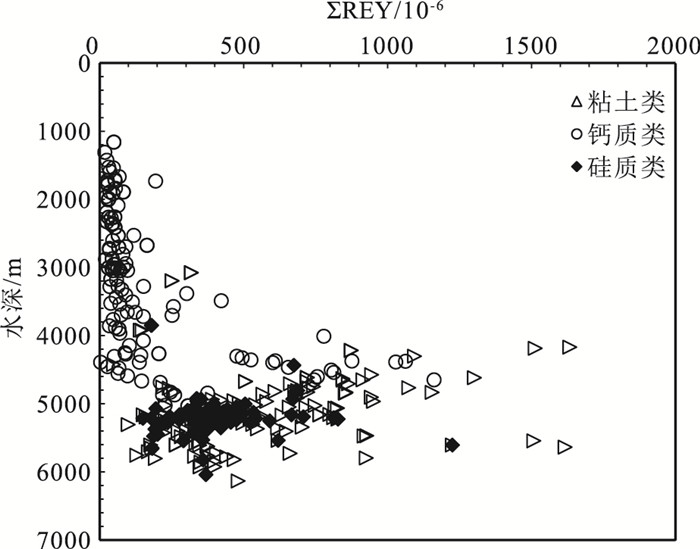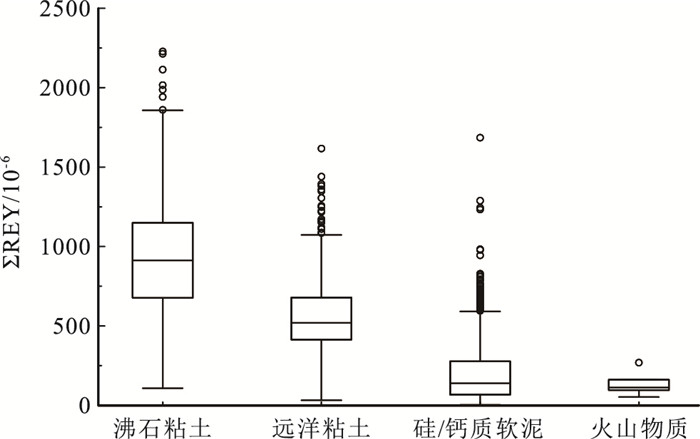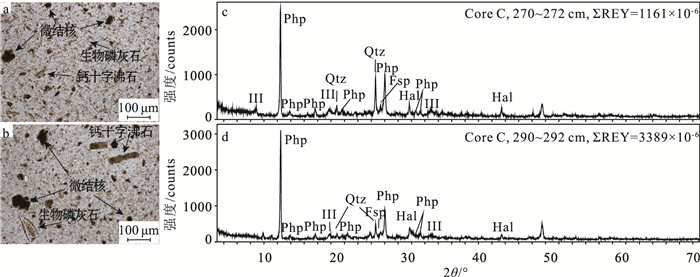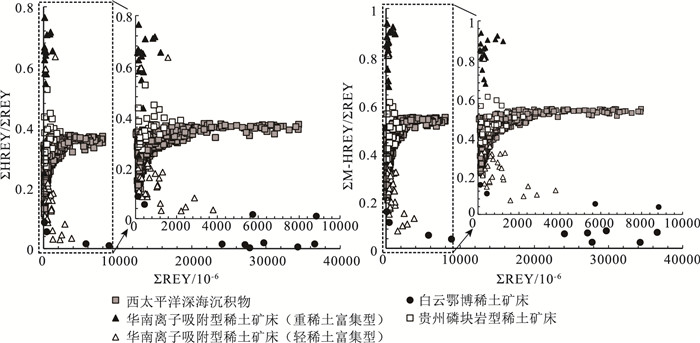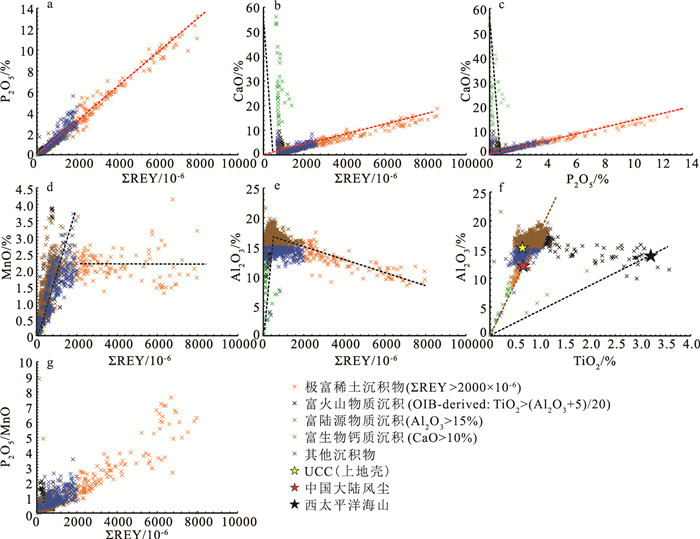Distribution and metallogenesis of deep-sea rare earth elements
-
摘要:
深海稀土是近年发现的一种富集中-重稀土的新型海洋矿产资源,其资源量远超陆地稀土储量,具有重要的潜在应用价值。中国是继日本之后在国际上第二个开展深海稀土调查研究的国家,2011年以来,先后在中印度洋海盆、东南太平洋和西太平洋深海盆地发现了大面积富稀土沉积区,在全球大洋中初步划分出4个深海稀土成矿带:西太平洋深海稀土成矿带、中—东太平洋深海稀土成矿带、东南太平洋深海稀土成矿带和中印度洋海盆-沃顿海盆深海稀土成矿带。深海富稀土沉积主要发育在深海盆地的沸石粘土和远洋粘土中,属于自生成因;部分发育在洋中脊附近的盆地中,受到热液作用的影响。研究发现,深海粘土中稀土元素主要赋存于生物磷灰石中,海水是稀土元素的主要来源;在早期成岩阶段,稀土元素在深海沉积物中发生转移和重新分配,并最终富集于生物磷灰石中;大水深(CCD面之下)、低沉积速率和强底流活动是深海稀土大规模成矿的主要控制因素。今后需要继续加大深海稀土基础调查,加强深海稀土调查探测技术研发,并开展海陆稀土成矿作用对比研究,揭示深海稀土成矿机制和规律。
Abstract:Rare earth elements and yttrium(REY) in the deep-sea sediment is a new type of marine mineral resource rich in middle-heavy rare earth discovered in recent years.The amount of REY in the deep sea sediment is far more than the terrestrial rare earth reserves, and it has important potential application value.China is the second country after Japan to conduct deep-sea REY survey and research.Since 2011, large areas of REY-rich sediments have successively been found in the central India Ocean, the southeast and western Pacific Ocean.The global ocean is divided into four REY metallogenic belts, namely the western Pacific Ocean one, the central and eastern Pacific Ocean one, the southeast Pacific Ocean one, and the central Indian Ocean-Wharton basin one.The deep-sea REY-rich sediments are mainly developed in the zeolite clay and pelagic clay in the deep-sea basin, which is of autogenetic origin.While some of them are developed near the mid-ocean ridge and are affected by the hydrothermal processes.It is found that the REY in deep-sea clay mainly occur in biological apatite, and seawater is the main source of REY.In the early diagenetic stage, REY was transferred and redistributed in deep-sea sediments, and finally enriched in biological apatite.It is suggested that low sedimentation rate and vigorous bottom currents are principal controlling factors for large-scale deep-sea REY mineralization in the deep water-depth(beneath the carbonate compensation depth).In the future, it is necessary to continue to increase the basic deep-sea REY survey, strengthen the research and development of deep-sea REY detection technology, and carry out the comparative study of marine and terrestrial REY mineralization, so as to reveal the deep-sea REY mineralization mechanism and regularity.
-

-
表 1 深海富稀土沉积成矿带特征对比(根据已有数据统计总结)
Table 1. Characteristics of four deep-sea REY metallogenic belts
海区 太平洋 印度洋 成矿带 西太平洋 东南太平洋 中—东太平洋 中印度洋海盆 沃顿海盆 主要沉积物类型 深海粘土(沸石粘土、远洋粘土) ΣREY/10-6 700~7974 700~2738 700~1732 700~1987 700~1113 ΣREY平均值/10-6 1330 1243 910 1120 815 >700×10-6的岩心数量/检测样品数量 54/819 38/607 26/387 55/756 1/34 主要赋存层位 >1.3 m;2~12 m发育3层ΣREY> 2000×10-6的稀土富集层 0~10 m 0~64 m;多层 0~5 m 103~122 m 主要赋存矿物 生物磷灰石为主,其次为铁锰微结核 -
[1] 范宏瑞, 牛贺才, 李晓春, 等. 中国内生稀土矿床类型、成矿规律与资源展望[J]. 科学通报, 2020, 65(33): 134-149. https://www.cnki.com.cn/Article/CJFDTOTAL-KXTB202033012.htm
[2] Gulley A L, Nassar N T, Xun S. China, the United States, and competition for resources that enable emerging technologies[J]. Proceedings of the National Academy of Sciences of the United States of America, 2018, 115: 4111-4115. doi: 10.1073/pnas.1717152115
[3] 袁忠信. 中国稀土矿床成矿规律[M]. 北京: 地质出版社, 2012.
[4] 柯昌辉, 孙盛, 赵永岗, 等. 内蒙古白云鄂博超大型稀土-铌-铁矿床控矿构造及深部找矿方向[J]. 地质通报, 2021, 40(1): 95-109. http://dzhtb.cgs.cn/gbc/ch/reader/view_abstract.aspx?file_no=20210109&flag=1
[5] 石学法, 符亚洲, 李兵, 等. 我国深海矿产研究: 进展与发现(2011-2020年)[J/OL]. 矿物岩石地球化学通报, 1-14[2021-02-03]. https://doi.org/10.19658/j.issn.1007-2802.2021.40.022.
[6] Kato Y, Fujinaga K, Nakamura K, et al. Deep-sea mud in the Pacific Ocean as a potential resource for rare-earth elements[J]. Nature Geoscience, 2011, 4(8): 535-539. doi: 10.1038/ngeo1185
[7] Takaya Y, Yasukawa K, Kawasaki T, et al. The tremendous potential of deep-sea mud as a source of rare-earth elements[J]. Scientific reports, 2018, 8(1): 1-8. http://europepmc.org/abstract/MED/29636486
[8] Nakamura K, Fujinaga K, Yasukawa K, et al. Chapter 268-REY-rich mud: A deep-sea mineral resource for rare earths and yttrium[C]//Handbook on the Physics and Chemistry of Rare Earths. Elsevier Science & Technology, 2015.
[9] Fujinaga K, Yasukawa K, Nakamura K, et al. Geochemistry of REY-rich mud in the Japanese Exclusive Economic Zone around Minamitorishima Island[J]. Geochemical Journal, 2016, 50(6): 575-590. doi: 10.2343/geochemj.2.0432
[10] Iijima K, Yasukawa K, Fujinaga K, et al. Discovery of extremely REY-rich mud in the western North Pacific Ocean[J]. Geochemical Journal, 2016, 50(6): 557-573. doi: 10.2343/geochemj.2.0431
[11] Yasukawa K, Ohta J, Mimura K, et al. A new and prospective resource for scandium: Evidence from the geochemistry of deep-sea sediment in the western North Pacific Ocean[J]. Ore Geology Reviews, 2018, 102: 260-267. doi: 10.1016/j.oregeorev.2018.09.001
[12] Yasukawa K, Ohta J, Mimura K, et al. A new and prospective resource for scandium: Evidence from the geochemistry of deep-sea sediment in the western North Pacific Ocean[J]. Ore Geology Reviews, 2018, 102: 260-267. doi: 10.1016/j.oregeorev.2018.09.001
[13] Yasukawa K, Ohta J, Miyazaki T, et al. Statistic and isotopic characterization of deep-sea sediments in the western north Pacific Ocean: Implications for genesis of the sediment extremely enriched in rare earth elements[J]. Geochemistry Geophysics Geosystems, 2019, 20(7): 3402-3430. doi: 10.1029/2019GC008214
[14] Mimura K, Nakamura K, Yasukawa K, et al. Significant impacts of pelagic clay on average chemical composition of subducting sediments: New insights from discovery of extremely rare-earth elements and yttrium-rich mud at Ocean Drilling Program Site 1149 in the western North Pacific Ocean[J]. Journal of Asian Earth Sciences, 2019, 186: 104059. doi: 10.1016/j.jseaes.2019.104059
[15] Tanaka E, Nakamura K, Yasukawa K, et al. Chemostratigraphy of deep-sea sediments in the western North Pacific Ocean: Implications for genesis of mud highly enriched in rare-earth elements and yttrium[J]. Ore Geology Reviews, 2020, 119: 103392. doi: 10.1016/j.oregeorev.2020.103392
[16] 黄牧. 太平洋深海沉积物稀土元素地球化学特征及资源潜力初步研究[D]. 国家海洋局第一海洋研究所硕士学位论文, 2013.
[17] 张霄宇, 邓涵, 张富元, 等. 西太平洋海山区深海软泥中稀土元素富集的地球化学特征[J]. 中国稀土学报, 2013, 31(6): 729-737. doi: 10.11785/S1000-4343.20130614
[18] 黄牧, 刘季花, 石学法, 等. 东太平洋CC区沉积物稀土元素特征及物源[J]. 海洋科学进展, 2014, 32(2): 175-187. doi: 10.3969/j.issn.1671-6647.2014.02.007
[19] 黄牧, 石学法, 刘季花, 等. 太平洋表层沉积物中δCe特征探讨[J]. 矿物学报, 2015, 35(S1): 762-763. https://www.cnki.com.cn/Article/CJFDTOTAL-KWXB2015S1561.htm
[20] 黄大松, 张霄宇. 中印度洋洋盆深海沉积泥的稀土元素载体和来源[J]. 矿物学报, 2015, 35(S1): 761. https://www.cnki.com.cn/Article/CJFDTOTAL-KWXB2015S1560.htm
[21] 萨日娜, 孙晓明, 潘晴晴, 等. 中太平洋深海沉积物的粒度特征及其对稀土元素含量的控制[J]. 矿物学报, 2015, 35(S1): 779-780. https://www.cnki.com.cn/Article/CJFDTOTAL-KWXB2015S1571.htm
[22] 任江波, 姚会强, 朱克超, 等. 稀土元素及钇在东太平洋CC区深海泥中的富集特征与机制[J]. 地学前缘, 2015, 22(4): 200-211. https://www.cnki.com.cn/Article/CJFDTOTAL-DXQY201504024.htm
[23] 方明山, 石学法, 肖仪武, 等. 太平洋深海沉积物中稀土矿物的分布特征研究[J]. 矿冶, 2016, 25(5): 81-84. doi: 10.3969/j.issn.1005-7854.2016.05.019
[24] 杨宝菊, 刘季花, 李传顺, 等. 南大西洋中脊含金属沉积物稀土元素特征[C]//第九届全国成矿理论与找矿方法学术讨论会论文摘要集(南京), 2019: 387.
[25] 于淼, 石学法, 李传顺, 等. 中印度洋海盆富稀土沉积物物质来源[C]//中国矿物岩石地球化学学会第17届学术年会, 2017.
[26] Sa R, Sun X, He G, et al. Enrichment of rare earth elements in siliceous sediments under slow deposition: A case study of the central North Pacific[J]. Ore Geology Reviews, 2018, 94: 12-23. doi: 10.1016/j.oregeorev.2018.01.019
[27] 周天成, 石学法. 东南太平洋尤潘基海盆富稀土沉积研究进展[C]//第九届全国成矿理论与找矿方法学术讨论会论文摘要集(南京), 2019.
[28] 张霄宇, 石学法, 黄牧, 等. 深海富稀土沉积研究的若干问题[J]. 中国稀土学报, 2019, 37(5): 517-529. https://www.cnki.com.cn/Article/CJFDTOTAL-XTXB201905001.htm
[29] 张霄宇, 黄牧, 石学法, 等. 中印度洋洋盆GC11岩心富稀土深海沉积的元素地球化学特征[J]. 海洋学报, 2019, 41(12): 51-61. https://www.cnki.com.cn/Article/CJFDTOTAL-SEAC201912005.htm
[30] 刘明, 孙晓霞, 石学法, 等. 印度洋钙质软泥和硅质软泥稀土元素组成和富集机制[J]. 海洋学报, 2019, 41(1): 58-71. https://www.cnki.com.cn/Article/CJFDTOTAL-SEAC201901007.htm
[31] Zhang X, Tao C, Shi X, et al. Geochemical characteristics of REY-rich pelagic sediments from the GC02 in central Indian Ocean Basin[J]. Journal of Rare Earths, 2017, 10(35): 113-124. http://www.cnki.com.cn/Article/CJFDTotal-YXTB201710015.htm
[32] Liao J, Sun X, Li D, et al. New insights into nanostructure and geochemistry of bioapatite in REE-rich deep-sea sediments: LA-ICP-MS, TEM, and Z-contrast imaging studies[J]. Chemical Geology, 2019, 512: 58-68. doi: 10.1016/j.chemgeo.2019.02.039
[33] Liao J, Sun X, Wu Z, et al. Fe-Mn(oxyhydr)oxides as an indicator of REY enrichment in deep-sea sediments from the central North Pacific[J]. Ore Geology Reviews, 2019, 112: 103044. doi: 10.1016/j.oregeorev.2019.103044
[34] Zhou T, Shi X, Huang M, et al. The Influence of Hydrothermal Fluids on the REY-Rich Deep-Sea Sediments in theYupanqui Basin, Eastern South Pacific Ocean: Constraints from Bulk Sediment Geochemistry and Mineralogical Characteristics[J]. Minerals, 2020, 10(12): 1141. doi: 10.3390/min10121141
[35] 朱克超, 任江波, 王海峰, 等. 太平洋中部富REY深海粘土的地球化学特征及REY富集机制[J]. 地球科学(中国地质大学学报), 2015, 40(6): 1052-1060. https://www.cnki.com.cn/Article/CJFDTOTAL-DQKX201506009.htm
[36] 朱克超, 任江波, 王海峰. 太平洋中部富REY深海沉积物的地球化学特征及化学分类[J]. 地球学报, 2016, 37(3): 287-293. https://www.cnki.com.cn/Article/CJFDTOTAL-DQXB201603005.htm
[37] 王汾连, 何高文, 孙晓明, 等. 太平洋富稀土深海沉积物中稀土元素赋存载体研究[J]. 岩石学报, 2016, 32(7): 2057-2068. https://www.cnki.com.cn/Article/CJFDTOTAL-YSXB201607009.htm
[38] 王汾连, 何高文, 王海峰, 等. 马里亚纳海沟柱状沉积物稀土地球化学特征及其指示意义[J]. 海洋地质与第四纪地质, 2016, 36(4): 67-75. https://www.cnki.com.cn/Article/CJFDTOTAL-HYDZ201604010.htm
[39] 王汾连, 何高文, 姚会强, 等. 深海沉积物中的稀土矿产资源研究进展[J]. 中国地质, 2017, 44(3): 449-459. https://www.cnki.com.cn/Article/CJFDTOTAL-DIZI201703005.htm
[40] 任江波, 何高文, 朱克超, 等. 富稀土磷酸盐及其在深海成矿作用中的贡献[J]. 地质学报, 2017, 91(6): 1312-1325. doi: 10.3969/j.issn.0001-5717.2017.06.011
[41] 邓义楠, 任江波, 郭庆军, 等. 太平洋西部富稀土深海沉积物的地球化学特征及其指示意义[J]. 岩石学报, 2018, 34(3): 733-747. https://www.cnki.com.cn/Article/CJFDTOTAL-YSXB201803013.htm
[42] 王汾连, 何高文, 赖佩欣. 太平洋富稀土深海沉积物及黏土组分(< 2μm)的Nd同位素特征及物源意义[J]. 大地构造与成矿学, 2019, 43(2): 292-302.
[43] 沈华悌. 深海沉积物中的稀土元素[J]. 地球化学, 1990, 4: 340-348. doi: 10.3321/j.issn:0379-1726.1990.04.009
[44] 刘季花. 太平洋东部深海沉积物稀土元素地球化学[J]. 海洋地质与第四纪地质, 1992, 12(2): 33-42. https://www.cnki.com.cn/Article/CJFDTOTAL-HYDZ199202005.htm
[45] 刘季花, 梁宏锋, 夏宁, 等. 东太平洋深海沉积物小于2μm组分的稀土元素地球化学特征[J]. 地球化学, 1998, 27(1): 49-58. doi: 10.3321/j.issn:0379-1726.1998.01.006
[46] 刘季花. 东太平洋沉积物稀土元素和Nd同位素地球化学特征及其环境指示意义[D]. 中国科学院研究生院(海洋研究所)博士学位论文, 2004.
[47] 许东禹. 大洋矿产地质学[M]. 北京: 海洋出版社, 2013.
[48] Pattan J N, Rao C M, Higgs N C, et al. Distribution of major, trace and rare-earth elements in surface sediments of the Wharton Basin, Indian Ocean[J]. Chemical Geology, 1995, 121(1/4): 201-215. http://www.sciencedirect.com/science/article/pii/000925419400112L
[49] Pattan J N, Parthiban G. Geochemistry of ferromanganese nodule-sediment pairs from Central Indian Ocean Basin[J]. Journal of Asian Earth Sciences, 2011, 40(2): 569-580. doi: 10.1016/j.jseaes.2010.10.010
[50] Yasukawa K, Liu H, Fujinaga K, et al. Geochemistry and mineralogy of REY-rich mud in the eastern Indian Ocean[J]. Journal of Asian Earth Sciences, 2014, 93: 25-36. doi: 10.1016/j.jseaes.2014.07.005
[51] Piper D Z. Rare earth elements in ferromanganese nodules and other marine phases[J]. Geochimica et Cosmochimica Acta, 1974, 38: 1007-1022. doi: 10.1016/0016-7037(74)90002-7
[52] Rudnick R, Gao S. Composition of the continental crust[C]//Holland H, Turekian K K. Treatise on Geochemistry. Amsterdam: Elsevier, 2014: 1-51.
[53] Taylor S R, McLennan S M. The continental crust: its composition and evolution[M]. Blackwell Scientific Publications, Oxford, 1985.
[54] Alibo D S, Nozaki Y. Rare earth elements in seawater: particle association, shale normalization, and Ce oxidation[J]. Geochimica et Cosmochimica Acta, 1999, 63: 363-372. doi: 10.1016/S0016-7037(98)00279-8
[55] 费红彩. 白云鄂博碱性岩系及稀土磁铁矿床成因研究[D]. 中国地质大学(北京)博士学位论文, 2005.
[56] Bao Z, Zhao Z. Geochemistry of mineralization with exchangeable REY in the weathering crusts of granitic rocks in South China[J]. Ore Geology Review, 2008, 33: 519. doi: 10.1016/j.oregeorev.2007.03.005
[57] Zhao Z, Wang D, Chen Z, et al. Progress of Research on Metallogenic Regularity of Ion-adsorption Type REE Deposit in theNanling Range[J]. Acta Geologica Sinica, 2017, 91(12): 2814-2817. http://en.cnki.com.cn/Article_en/CJFDTOTAL-DZXE201712016.htm
[58] 王文全. 湘黔地区海相磷块岩地球化学特征及铀多金属富集作用[D]. 核工业北京地质研究院博士学位论文, 2016.
[59] Toyoda K, Tokonami M. Diffusion of rare-earth elements in fish teeth from deep-sea sediments[J]. Nature, 1990, 345: 607-609. https://doi.org/10.1038/345607a0. doi: 10.1038/345607a0
[60] Kon Y, Hoshino M, Sanematsu K, et al. Geochemical Characteristics of Apatite in Heavy REE-rich Deep-Sea Mud from Minami-Torishima Area, Southeastern Japan[J]. Resource Geology, 2014, 64(1): 47-57. doi: 10.1111/rge.12026
[61] Kashiwabara T, Toda R, Fujinaga K, et al. Determination of host phase of lanthanum in deep-sea REY-rich mud by XAFS and-XRF using high-energy synchrotron radiation[J]. Chemistry Letters, 2014, 43(2): 199-200. doi: 10.1246/cl.130853
[62] Dubinin A V. Geochemistry of rare earth elements in oceanic phillipsites[J]. Lithology and Mineral Resources, 2000, 35(2): 101-108. doi: 10.1007/BF02782672
[63] Gallet S, Jahn B, Torii M. Geochemical characterization of the Luochuan loess-paleosol sequence, China, and paleoclimatic implications[J]. Chemical Geology, 1996, 133(1/4): 67-88. http://www.sciencedirect.com/science/article/pii/S0009254196000708
[64] Sun J, Zhu X. Temporal variations in Pb isotopes and trace element concentrations within Chinese eolian deposits during the past 8 Ma: Implications for provenance change[J]. Earth and Planetary Science Letters, 2010, 290(3/4): 438-447.
[65] Cristie D M, Dieu J J, Gee J S. Petrologic studies of basement lavas from northwest Pacific guyots. [C]//Haggerty J A, Premoli Silva I, Rack F, et al. Proceedings of the Ocean Drilling Program, Scientific Results, College Station, TX: Ocean Drilling Program, 1995, 144: 495-512.
[66] 汪春园, 王玲, 贾木欣, 等. 大洋沉积物中稀土赋存状态研究[J]. 稀土, 2020, 41(3): 17-25. https://www.cnki.com.cn/Article/CJFDTOTAL-XTZZ202003003.htm
[67] Deng Y, Ren J, Guo Q, et al. Rare earth element geochemistry characteristics of seawater and porewater from deep sea in western Pacific[J]. Scientific Reports, 2017, 7(1): 16539. doi: 10.1038/s41598-017-16379-1
[68] Bright C A, Cruse A M, Lyons T W, et al. Seawater rare-earth element patterns preserved in apatite of Pennsylvanian conodonts[J]. Geochimica et Cosmochimica Acta, 2009, 73: 1609. doi: 10.1016/j.gca.2008.12.014
[69] Elderfield H, Pagett R. Rare earth elements in ichthyoliths: variations with redox conditions and depositional environment[J]. Science of the Total Environment, 1986, 49: 175-197. doi: 10.1016/0048-9697(86)90239-1
[70] Zhao L S, Chen Z Q, Algeo T J, et al. Rare-earth element patterns in conodontalbid crowns: Evidence for massive inputs of volcanic ash during the latest Permian biocrisis[J]. Global Planetary Change, 2013, 105(6): 135-151. http://www.sciencedirect.com/science/article/pii/S0921818112001774
[71] Wright J, Schrader H, Holser W T. Paleoredox variations in ancient oceans recorded by rare earth elements in fossil apatite[J]. Geochimica et Cosmochimica Acta, 1987, 51: 631-644. doi: 10.1016/0016-7037(87)90075-5
[72] Oudin E, Cocherie A. Fish debris record the hydrothermal activity in the Atlantis II Deep sediments(Red Sea)[J]. Geochimica et Cosmochimica Acta, 1988, 52: 177-184. http://www.sciencedirect.com/science/article/pii/0016703788900658
[73] 杨瑞东, 高慧, 王强, 等. 贵州织金三甲寒武系戈仲伍组含磷岩系稀土富集规律研究[J]. 中国稀土学报, 2005, (6): 742-748. https://www.cnki.com.cn/Article/CJFDTOTAL-XTXB200506022.htm
[74] 解启来, 陈多福, 漆亮, 等. 贵州瓮安陡山沱组磷块岩的稀土元素地球化学特征与沉积古环境[J]. 矿物学报, 2003, (4): 2-8. https://www.cnki.com.cn/Article/CJFDTOTAL-KWXB200304001.htm
[75] Emsbo P, Mclaughlin P I, Breit G N, et al. Rare earth elements in sedimentary phosphate deposits: Solution to the global REE crisis[J]. Gondwana Research, 2015, 27(2): 776-785. http://www.sciencedirect.com/science/article/pii/S1342937X14003128
[76] 吴发富, 王建雄, 刘江涛, 等. 磷矿的分布、特征与开发现状[J]. 中国地质, 2021, 48(1): 82-101.
[77] Ronsbo J G. Coupled substitutions involving REEs and Na and Si in apatites in alkaline rocks from the Ilimaussaq intrusion, South Greenland, and the petrological implications[J]. American Mineralogist, 1989, 74: 896-901. http://ci.nii.ac.jp/naid/80004765761
[78] Pan Y, Fleet M E. Compositions of the apatite-group minerals: substitution mechanisms and controlling factors[J]. Reviews in Mineralogy Geochemistry, 2002, 48: 13-49. http://www.researchgate.net/publication/250130595_Compositions_of_the_Apatite-Group_Minerals_Substitution_Mechanisms_and_Controlling_Factors
[79] Hughes J M, Rakovan J F. Structurally robust, chemically diverse: apatite and apatite supergroup minerals[J]. Elements, 2015: 165-170. http://www.researchgate.net/publication/277919350_Structurally_Robust_Chemically_Diverse_Apatite_and_Apatite_Supergroup_Minerals
[80] 王中刚, 于学元, 赵振华. 稀土元素地球化学[M]. 北京: 科学出版社, 1987.
[81] Li D, Fu Y, Liu Q, et al. High-resolution LA-ICP-MS mapping of deep-sea polymetallic micronodules and its implications on element mobility[J]. Gondwana Research, 2020, 81: 461-474. http://www.sciencedirect.com/science/article/pii/S1342937X20300290
[82] Kashiwabara T, Toda R, Nakamura K, et al. Synchrotron X-ray spectroscopic perspective on the formation mechanism of REY-rich muds in the Pacific Ocean[J]. Geochimica et Cosmochimica Acta, 2018, 240: 274-292. http://www.sciencedirect.com/science/article/pii/S0016703718304411
[83] VanAndel T H. Mesozoic/Cenozoic calcite compensation depth and the global distribution of calcareous sediments[J]. Earth Planetary Science Letters, 1975, 26(2): 187-194. http://www.sciencedirect.com/science/article/pii/0012821X75900862
[84] Wheeler A J, Stadnitskaia A. Benthic deep-sea carbonates: reefs and seeps[C]//Huneke H, Mulder T. Deep-Sea Sediments. Developments in Sedimentology. Elsevier, Netherlands, 2011.
[85] Heezen B C, MacGregor I D, Foreman H P, et al. The post Jurassic sedimentary sequence on the Pacific plate: a kinematic interpretation of diachronous deposits[C]//Heezen B C, MacGregor I D. The Initial Reports of the Deep Sea Drilling Project, vol. 20. U.S. Government Printing Office, Washington, DC, 1973.
[86] Huneke H, Henrich R. Pelagic sedimentation in modern and ancient oceans[C]//Huneke H, Mulder T. Deep-Sea Sediments. Developments in Sedimentology. Elsevier, Netherlands, 2011.
[87] Ohta J, Yasukawa K, Machida S, et al. Geological factors responsible for REY-rich mud in the western North Pacific Ocean: Implications from mineralogy and grain size distributions[J]. Geochemical Journal, 2016, 50(6): 591-603. http://ci.nii.ac.jp/naid/130005435146
[88] Plank T, Langmuir C H. The chemical composition of subducting sediment and its consequences for the crust and mantle[J]. Chemical Geology, 1998, 145(3/4): 325-394. http://www.sciencedirect.com/science/article/pii/S0009254197001502
[89] Archer D E. An atlas of the distribution of calcium carbonate in sediments of the deep sea[J]. Global Biogeochemical Cycles, 1996, 10(1): 159-174. http://onlinelibrary.wiley.com/doi/10.1029/95GB03016/epdf
① 石学法, 李传顺, 黄牧, 等. 国际海域资源调查与开发"十二五"课题"世界大洋海底稀土资源潜力评估报告". 2015.
② 王淑玲, 吴西顺, 田黔宁, 等. 日本对南鸟礁周边海域稀土沉积物的资源潜力评估. 海洋地质信息, 2016.
③ 石学法, 杨刚, 黄牧, 等. 中国大洋34航次第五航段调查现场报告. 2015.
④ 石学法, 杨刚, 黄牧, 等. 中国大洋46航次第四航段调查现场报告. 2018.
⑤ 石学法, 杨刚, 黄牧, 等. 中国大洋46航次第五航段调查现场报告. 2018.
⑥ 2015第四十四届世界海洋矿产大会(Underwater Mining Conference, UMC).
⑦ 石学法, 杨刚, 黄牧, 等. 中国大洋62航次调查现场报告. 2020.
-




 下载:
下载:
